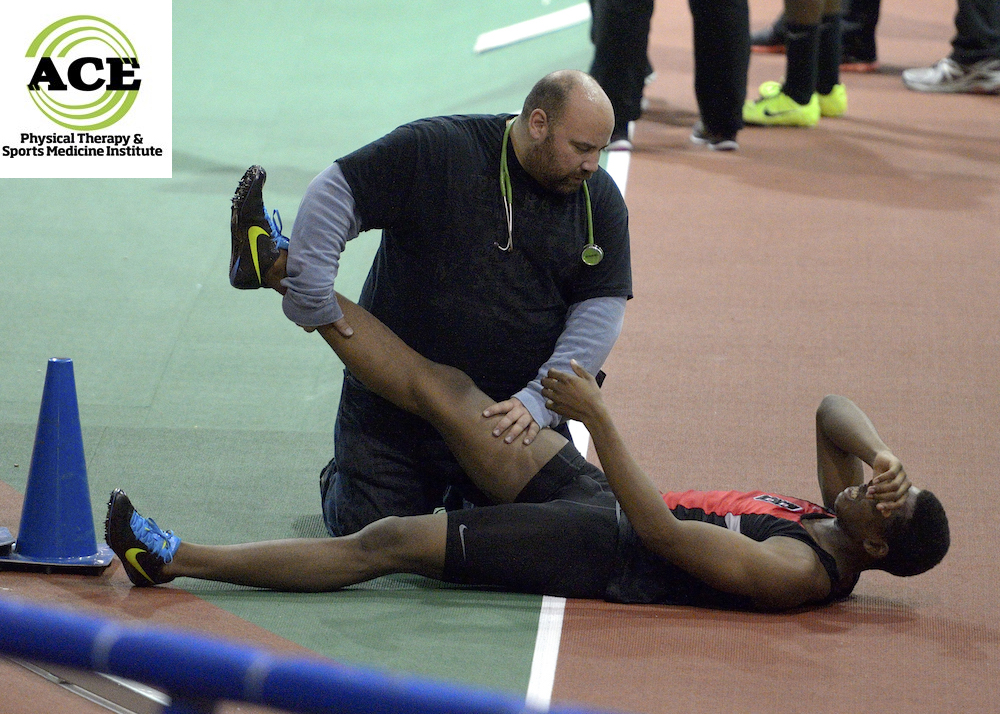WHY DO HAMSTRING INJURIES TAKE SO LONG TO HEAL?
Why do Hamstring injuries take so long to heal?
by ACE Physical Therapy and Sports Medicine Institute
Tid Bits of Info.
- Hamstring injuries usually occur in conjunction with a sudden lunge, jump or burst of speed.
- Hamstring injuries usually occur in the region near the buttocks (tendon injury) or in the middle of the muscle (muscle tissue).
- Injuries to the hamstring near the buttocks usually take longer to heal due to the tendon tissue not having a lot of blood flow.
- Some studies indicate that it can take 18 months for a hamstring injury to heal and the average time is 3-4 months.
- Seek the advice and treatment of a Physical Therapist if you injure your hamstring.
The ball comes flying across the tennis court and is headed to the far-left corner. A quick dart to left to hit the ball and suddenly sharp pain in the back of the thigh. Hamstring injuries often occur in sports that involve sprinting with sudden starts and stops like tennis, basketball, soccer, dancing, and more. While an injured hamstring can take over a year to heal, Physical Therapists can help patients reduce pain, regain motion and return to their activities.
Understanding the Hamstring Muscle
The hamstring muscles extend from the pelvis to the back of the lower leg bone (Tibia) and cross over the hip and knee joints. There are three hamstring muscles and they act to flex the knee and extend the hip. Their ability to do both motions at the same time is limited to a certain range of motion. Fortunately, we don’t rely on maximum force output from the hamstrings very often throughout the course of a day.
The hamstrings control the hip and knee joints utilizing two specific types of muscle contraction during everyday activities. Isometric contractions (fibers do not move) rarely cause an injury therefore they will not be included in this discussion. The muscles contract in a way that the fibers shorten (concentric contraction) or lengthen (eccentric contraction) to generate force to move the joint or control the speed of the joint. During a concentric contraction, the hip will extend and the knee flexes. During an eccentric contraction the shin bone or Tibia is decelerated during the swing phase of gait. The deceleration is needed to control the knee and ankle when the foot makes contact with the ground.
Most hamstring injuries occur in one of two ways. The muscles are strained and injured when they contract violently to enable someone to run/sprint or when the muscles are over stretched and cause tissue damage. The hamstring muscles, like all “2” joint muscles are designed for speed and not power. When someone breaks into a sprint the forces generated by the hamstrings muscles are violent. They concentrically contract to help extend the hip to move the body forward and eccentrically contract to decelerate the tibia and knee joint when it is being extended to put the foot on the ground during the swing through phase of gait. The deceleration helps the runner maintain balance and control. If someone slips and falls they might experience a stretch injury to the hamstrings. The muscle can stretch quite a bit due to the elastin in the muscle cell but the musculoskeletal junction and tendon are not nearly as flexible. The makeup of these areas is similar to leather and can be damaged when stretched too far or too aggressively.
Hamstring Injuries Heal Slowly
Many people that have experienced these injuries deal with the symptoms for months and have a difficult time returning to many of their exercises and activities without the fear of a reoccurrence. It is not uncommon to deal with the symptoms associated with a hamstring injury for many months. Some studies indicate that the healing time can commonly extend beyond the one year mark.
Hamstring injuries take a long time to heal due to function of the muscle. Their involvement in motions at the hip and knee cause the muscle to be under a great deal of stress and strain during most activity. The different types of muscle contraction that occur to control or move the joints play an important role in the amount of time that is required to heal. Acute symptoms include sudden sharp pain in the back of the thigh, possible developing bruising and a palpable defect in the muscle tissue.
Physical Therapy for Pain and Recovery
If you ever suffered an injury to your hamstring muscles you know how painful and debilitating the injury can be to your daily life. Physical Therapy can help. The therapy treatment will address the acute symptoms and help to reduce pain and swelling. Many times the ability to flex the knee or hip is reduced due to the pain in the damaged muscle. Regaining motion is a primary goal of therapy. Once the acute symptoms have resolved the focus of the treatment must be to restore the strength and muscular endurance of the injured muscle. The Physical Therapist will include exercises that are designed to rebuild the strength of the injured muscle. These exercises will incorporate a great deal of eccentric loading of the injured muscle tissue. High speed resistive exercises are needed to develop the muscle fully and restore the function to a pre-injury status.
Hamstring injuries are common in all sports and in many instances can limit someone’s participation in that activity for a prolonged period of time. Proper preparation for an activity can help to prevent the injuries from occurring and formal Physical Therapy treatment can speed up the healing process enabling the injured person to return to their desired activity.
Read more articles on our main website blog at: ACE-pt.org/blog
Vist our main website at www.ACE-pt.org


